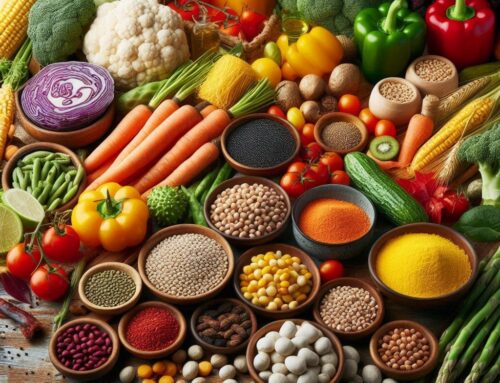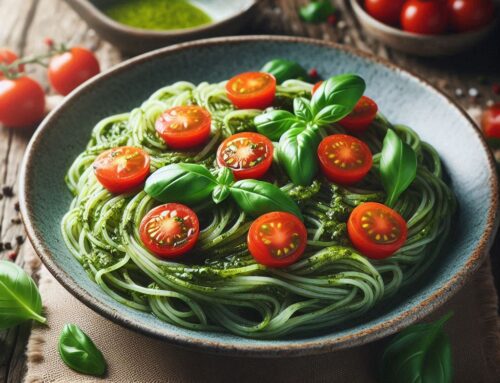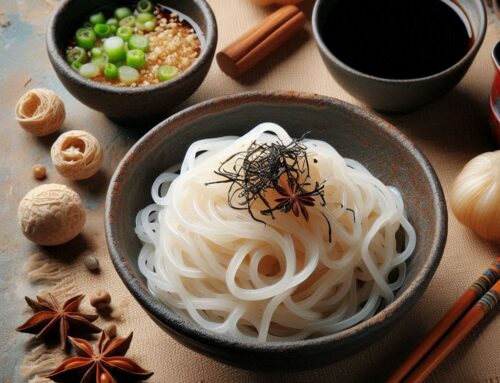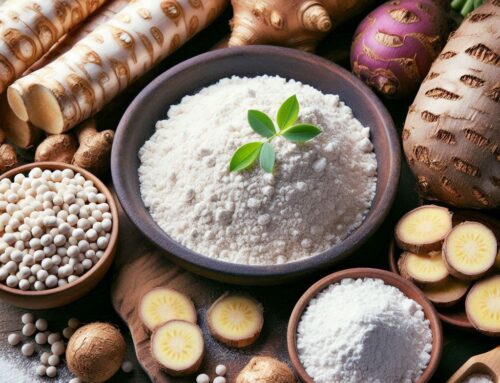
Introduction to Konjac: A Nutritional and Culinary Marvel
Konjac, often hailed as a superfood, is making waves in the health and culinary world. But what exactly is it? Derived from the root of the Amorphophallus konjac plant, this unique ingredient has been a staple in Asian cuisine for centuries. Its popularity stems not only from its versatility in cooking but also from its impressive nutritional profile.
At the heart of konjac’s nutritional benefits is glucomannan, a dietary fiber known for its ability to absorb water and expand in your stomach, promoting feelings of fullness. This makes konjac an excellent choice for those looking to manage their weight or improve digestive health. It’s low in calories yet high in fiber, offering a satisfying option without compromising on dietary goals.
The culinary uses of konjac are as diverse as they are delightful. From noodles and rice substitutes to gel-like desserts and snacks, konjac can be adapted into various dishes that suit both savory and sweet palates. Its neutral taste allows it to absorb flavors well, making it an ideal base for countless recipes.
Embracing konjac in your diet not only opens up new culinary possibilities but also provides numerous health benefits that support overall well-being. Whether you’re exploring new superfoods or looking for innovative ways to enhance your meals, konjac offers a nutritious solution that’s worth considering.
The Historical Roots of Konjac: Tracing Its Origins
The historical roots of konjac take us on a journey through time, revealing the fascinating origins and uses of this unique plant. Native to Southeast Asia, konjac, also known as Amorphophallus konjac, has been cultivated for centuries. Its history is deeply intertwined with the culinary and medicinal traditions of countries like Japan and China.
The origin of konjac can be traced back to ancient times when it was first used by Chinese herbalists over 2,000 years ago. They valued it for its health benefits and incorporated it into traditional remedies. In Japan, konjac made its way into the culinary landscape during the 6th century, becoming a staple in Buddhist vegetarian cuisine due to its low-calorie content and gelatinous texture.
Throughout history, the use of konjac expanded beyond medicinal purposes. It became an integral ingredient in traditional foods such as shirataki noodles and konnyaku jelly. These dishes highlight the versatility of konjac in absorbing flavors while providing a satisfying texture.
Understanding the history of konjac not only enriches our appreciation for this remarkable plant but also sheds light on its enduring presence in modern diets around the world. As we trace its origins from ancient use to contemporary applications, we see how deeply rooted it is within cultural traditions that continue to celebrate its unique properties today.
Cultural Significance: How Different Cultures Value Konjac
It is a humble root native to Asia, holds significant cultural importance across various cultures, particularly in Japan and other Asian countries. In Japan, it is known as “konnyaku” and has been a staple in the diet for centuries. Its unique texture and ability to absorb flavors make it a versatile ingredient in traditional Japanese cuisine. Often found in dishes like oden—a simmering hot pot of assorted ingredients—and sukiyaki, konjac is valued not only for its culinary uses but also for its health benefits.
In broader Asian cuisine, it plays an essential role due to its low-calorie content and high fiber levels. It fits seamlessly into the dietary practices of cultures that prioritize health-conscious eating habits. The gelatinous texture of konjac makes it an ideal substitute in recipes requiring noodles or gelatin-based products, thus expanding its use cases within various traditional dishes.
The cultural significance of konjac extends beyond mere nutrition; it symbolizes adaptability and resourcefulness within these communities. As more people around the world discover the benefits of this remarkable plant, konjac continues to bridge culinary traditions with modern dietary needs, highlighting its enduring importance across different cultures.
The Journey of Konjac from East to West: Global Popularity and Adoption
The journey of konjac from East to West is a fascinating tale of cultural exchange and growing health consciousness. Known for centuries in Asia, it has recently made significant strides in gaining popularity across the globe, particularly in Western countries. This root vegetable, often hailed as a superfood, has captivated the attention of health enthusiasts and nutritionists alike due to its impressive benefits.
The global spread of konjac can be attributed to the increasing awareness of its health advantages. Rich in glucomannan fiber, konjac is celebrated for its ability to aid digestion, promote weight loss, and regulate blood sugar levels. As more people seek natural ways to enhance their well-being, the demand for such superfoods has surged.
In the 2020s, the western adoption of superfoods like konjac has been driven by trends that emphasize plant-based diets and sustainable living. Consumers are becoming more selective about what they consume and are drawn towards foods that offer both nutritional value and environmental sustainability.
As part of this broader movement towards healthier lifestyles, it products such as noodles and rice have become staples in many Western kitchens. These low-calorie alternatives provide a guilt-free way to enjoy traditional dishes without compromising on taste or texture.
Ultimately, the journey of konjac from East to West highlights a growing global appreciation for diverse culinary traditions and an increased focus on health benefits awareness. As this trend continues to evolve, it will be interesting to see how other superfoods follow suit in capturing worldwide interest.
Nutritional Profile and Health Benefits that Make Konjac a Superfood
Konjac, often hailed as a superfood, is gaining attention for its impressive nutritional profile and health benefits. At the heart of konjak’s appeal is glucomannan, a dietary fiber that offers numerous advantages. Glucomannan is renowned for its ability to absorb water and expand in the stomach, which can promote a feeling of fullness and aid in weight management. This makes konjak an excellent low-calorie food option for those looking to control their calorie intake without sacrificing satiety.
The health benefits of konjak extend beyond weight management. The high fiber content supports digestive health by promoting regular bowel movements and maintaining gut health. Additionally, glucomannan has been linked to improved blood sugar levels and cholesterol reduction, making it beneficial for individuals managing diabetes or cardiovascular concerns.
Incorporating konjak into your diet is simple due to its versatility. It can be found in various forms such as noodles, rice substitutes, and even supplements. By including this superfood in your meals, you can enjoy both the culinary diversity it offers and the myriad health benefits it provides.
Modern Uses and Innovations in Using Konjac Today
Konjac, a plant native to Asia, has become a star ingredient in modern kitchens and is at the forefront of innovation in healthy eating. Known for its low-calorie content and high fiber benefits, konjac is increasingly being incorporated into modern recipes that cater to the growing demand for healthy and sustainable food sources.
One of the most exciting innovations is the use of konjac in plant-based diet trends. As more people seek alternatives to traditional carbohydrates, konjac noodles and rice have emerged as popular substitutes. These products offer a similar texture to pasta or rice but with significantly fewer calories, making them ideal for those looking to maintain a balanced diet without sacrificing flavor or satisfaction.
Additionally, konjac’s versatility extends beyond just noodles. It can be found in snacks like chips and jellies that appeal to health-conscious consumers seeking guilt-free indulgence. The rise of these products highlights how konjac is revolutionizing our approach to snacking by providing nutrient-rich options that align with sustainable food practices.
Furthermore, the environmental impact of konjac cultivation contributes positively to its appeal as a sustainable food source. The plant requires minimal resources compared to other crops, supporting eco-friendly agricultural methods that are crucial in today’s climate-conscious world.
In conclusion, modern uses of konjak underscore its role as an innovative component within healthy eating paradigms. By embracing this versatile ingredient, individuals can enjoy diverse culinary experiences while supporting their health goals and contributing to environmental sustainability efforts.






